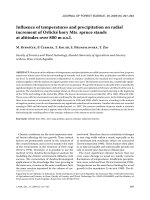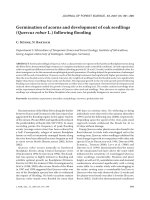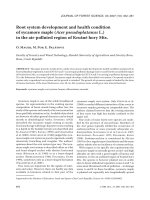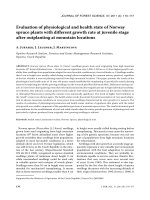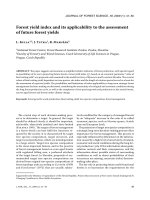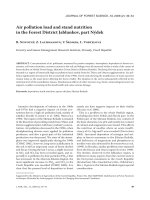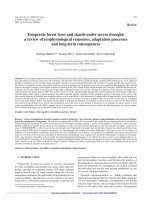Báo cáo lâm nghiệp: "Aboveground litter production and bioelement potential return in an evergreen oak (Quercus rotundifolia) woodland near Salamanca (Spain)" docx
Bạn đang xem bản rút gọn của tài liệu. Xem và tải ngay bản đầy đủ của tài liệu tại đây (473.74 KB, 8 trang )
Short
note
Aboveground
litter
production
and
bioelement
potential
return
in
an
evergreen
oak
(Quercus
rotundifolia)
woodland
near
Salamanca
(Spain)
A
Martín
1
JF
Gallardo
2
I
Santa
Regina
2
1
Area
de
Edafología,
Universidad
de
Salamanca,
Salamanca
37080;
2
IRNA/CSIC,
Apdo
257,
Salamanca
37071,
Spain
(Received
6
February
1995;
accepted
20 June
1995)
Summary -
Total
aboveground
production
of
trees
has
been
determined
in
a
Quercus
rotundifolia
evergreen
oak
woodland
developed
over
a
chromic
Luvisol.
The
woodland
is
located
close
to
the
city
of
Salamanca
(central-western
Spain).
Litter
fall
occurs
throughout
the
year,
with
a
maximum
from
April
to
June
owing
to
leaf
fall.
Mean
litter
production
is
1.9
Mg
ha-1
year
-1
,
although
variations
from
year
to
year
are
observed,
mostly
due
to
water
stress
in
summer.
The
mean
area
of
influence
of
litter
fall
of
each
tree
is
about
4
m
outside the
crown
shadow
and
the
leaf
percentage
(55%)
over
the
total
aboveground
litter
production
shows
that
the
system
is
mature.
Tree
inflorescences
are
found
to
have
the
highest
concentration
in
bioelements,
although
the
latter
are
mostly
returned
through
the
leaves
(with
the
exception
of
K).
biogeochemical
cycles
/ litter
fall
/ evergreen
oak
/
Quercus
rotundifolia
Lam
/
potential
return
of
bioelements
Résumé -
Production
de
litière
et
restitution
au
sol
de
bioéléments
dans
une
chênaie
(Quercus
rotundifolia)
près
de
Salamanque
(Espagne).
On
a
déterminé
la
production
de
litière
dans
une
chênaie
à
Quercus
rotundifolia
développée
sur
un
Luvisol
chromique
dans
les
environs
de
Salaman-
que
(ouest
de
l’Espagne).
La
chute
de
litière
s’étaie
sur
toute
l’année,
avec
un
maximum
dans
la
période
avril-juin,
principale
époque
de
retombée
des
feuilles.
La
production
moyenne
de
litière
est
de
1.9
Mg
ha-1
an-1
,
avec
des
variations
interannuelles
dues
au
stress
hydrique
pendant
l’été.
Dans
cette
chênaie
claire
(«
dehesa
»)
arrivée
à
maturité,
l’influence
de
l’arbre
s’étend jusqu’à
une
distance
de
4
m
à
partir
de
la
base
du
tronc.
Les
inflorescences
sont,
en
général,
les
organes
ayant
les
plus
fortes
teneurs
relatives
en
bioéléments.
Mais
le
plus
grand
retour
potentiel
des
bioéléments
se
fait
par
l’intermédiaire
des
feuilles
(excepté
pour
K,
qui
retourne
plutôt
avec
les
inflorescences).
cycle
biogéochimique
/ chute
de
litière
/
chênaie
/ Quercus
rotundifolia
Lam
/
restitution
des
nutriments
au
sol
*Correspondence
and
reprints
INTRODUCTION
The
biogeochemical
cycle
of
organic
mat-
ter
and
mineral
elements
is
the
main
aspect
of
the
relationships
between
soil
and
vege-
tation
and
thus
is
an
essential
ecological
phenomenon
in
natural
biocenosis,
in
par-
ticular
in
forest
populations
(Rapp,
1969).
In
a
forest
ecosystem,
in
general,
annual
plant
production
is
mainly
reflected
in
a
massive
contribution
of
dead
organic
mat-
ter,
which
accumulated
on
the
soil
(Mange-
not
and
Toutain,
1980).
The
litter
accumu-
lated
on
the
ground,
together
with
the
residual
organic
matter
coming
from
the
root
decomposition,
is
the
essential
source
of
energy,
C,
N,
K,
P
and
other
bioelements
for the
microflora
and
mesofauna
of the
soil
(McClaugherty
et
al,
1982),
as
well
as
an
amount
of
nutrients
readily
available
and
reutilizable
by
the
plant
cover
(Rapp
and
Leonardi,
1988).
In
ecosystems
located
on
’dehesa’
hilly
areas
(low
tree
density
ecosystems
and
wide
open
spaces
populated
with
herba-
ceous
species;
Escudero
et
al,
1985),
the
tree
covering
also
exerts
a
considerable
in-
fluence
on
soil
properties
(Escudero
and
García,
1986).
Owing
to
the
separation
of
one
tree
from
the
other,
this
influence
is
reflected
in
great
spatial
heterogeneity
in
soil
composition
(Escudero,
1983)
due
both
to
the
differences
in
the
amounts
of
detritus
reaching
the
soil
and
to
greater
susceptibility
to
decomposition
in
open
areas.
Nevertheless,
Santa
Regina
et
al
(1989)
did
not
find
significant
differences
in
the
litter
decomposition
below
trees
in
rela-
tion
to
open
areas.
The
aim
of
the
present
work
was
to
quan-
tify
and
determine
the
temporal
and
spatial
distribution
of
the
litter
fall
in
evergreen
oaks
and
to
determine
the
potential
return
of
bioelements
to
the
soil
and
the
relation-
ship
between
this
return
and
the
concentra-
tion of
bioelements
in
the
upper
soil
hor-
izons
of
the
woodland
studied.
MATERIALS
AND
METHODS
A
1
ha
experimental
plot
located
at
840
m
asl,
11
km
to
the
west
of
the
city
of
Salamanca
at
the
Muñovela
experimental
farm
(CSIC)
was
chosen
for
this
study.
The
plot
is
edaphically
homo-
geneous,
with
a
dehesa-like
woodland.
Pre-
viously
it
was
heavily
grazed
although
it
is
now
fenced
off
to
prevent
the
access
of
domestic
ani-
mals.
The
climate
of
the
zone
features
rainy
winters
and
hot
summers
and
may
be
classified
as
semi-
arid
Mediterranean.
Long-term
mean
rainfall
and
temperature
have
mean
values
of
500
mm year
-1
and
10.8
°C,
respectively,
although
the
means
of
the
3
years
of
the
study
period
were
370
mm year
-1
and
11.5
°C,
October
being
the
rainiest
month
(83.8
mm)
and
July
the
driest
(12.7
mm).
January
is
normally
the
coldest
month
(2.0
°C)
and
July
the
hottest
(22.0
°C).
The
tree
covering
comprises
Quercus
rotundi-
folia
Lam,
with
a
density
of
98
trees ha
-1
,
a
mean
height
of
5.9
m
and
a
mean
diameter
of
29.1
cm.
The
soil
is
a
chromic
Luvisol,
developed
over
red
clays
and
Miocene
conglomerates.
The
slope
of
the
plot
is
5%.
Determination
of
the
litter
production
was
per-
formed
by
placing
30
collecting
boxes
of
0.24
m2
of
surface
area
distributed
according
to
a
net-
work
arrangement
(five
series)
and
occupying
a
surface
of
2
050
m2.
The
amount
of
litter
fallen
into
the
boxes
was
collected
at
approximately
monthly
intervals
and
separated
into
individual
components
(leaves,
branches,
inflorescences,
fruit
and
others),
weighing
each
after
drying
at
80 °C.
The
following
methods
were
used
for
chemical
analysis
of
the
different
litter
compo-
nents:
total
C,
dry
combustion
with
a
Carmho-
graph
12
Wösthoff;
total
N
with
a
Heraeus
Macro-N
analyzer;
P
by
colorimetry
using
the
vanadomolybdophoshoric
yellow
colorimetric
method
(spectrophotometer
Varian
DMS
90);
Ca,
Mg,
Mn,
Fe,
Cu
and
Zn
by
atomic
absorption
spectrophotometry
(Varian
1475);
K
and
Na
by
flame
photometry
(Varian
1475).
The
soil
samples
were
taken
from
the
horizon
of
a
soil
profile
where
the
edaphic
morphologies
had
been
previously
described.
Analytical
deter-
minations
of
the
soils
were
as
follows:
organic
C
by
the
wet
method
according
to
the
potassium
dichromate
method;
total
N
with
a
Heraeus
Macro-N
analyzer;
assimilable
Ca,
Mg
and
K
by
extraction
with
1
N ammonium
acetate
(pH
7.0);
assimilable
P
according
to
the
method
of
Bray-
Kurtz
(1945);
cation
exchange
capacity
accord-
ing
to
the
method
of
Black
et
al
(1965).
Exchange
cations
were
extracted
following
the
ammonium
acetate
(pH
7.0)
method
and
analyzed
by
atomic
absorption
spectrophotometry
(Varian
1475).
In
general,
samples
were
analyzed
by
duplicate,
in
some
cases
by
triplicate.
For
the transformation
of
initial
g
kg-1
to
kg
ha-1
,
the
soil
horizon
depths,
bulk
density
and
stoniness
were
previously
known;
the
Ah
epipedon
refers
to
a
depth
of
20 cm.
RESULTS
AND
DISCUSSION
The
initial
data
available
correspond
to
three
annual
cycles
(March
1990-March
1993)
with
respect
to
the
contribution
of
tree
remains
(dry
matter)
to
the
soil
and
to
only
two
cycles
(March
1990-March
1992)
as
regards
chemical
composition.
Results
are
shown
in
tables
I to
IV.
Contribution
of
detritic
matter,
temporal
and
spatial
distribution
As
reported
earlier,
the
study
was
per-
formed
on
a
dehesa-like
woodland and
hence
there
are
open
areas.
In
this
plot,
the
crowns
of
the
trees
occupy
a
surface
area
of
3
070
m2
ha-1
and
thus
70%
of
the
sur-
face
is
clear
(temporal
pasture),
although
the
influence
of
the
trees
extends
to
a
greater
surface
area
than
that
correspond-
ing
to
the
crowns.
To
determine
this
in-
fluence,
the
(positive)
distance
from
each
box
to
the
edge
of
the
crown
of
the
closest
tree
was
determined,
assuming
that
the
distances
are
negative
when
the
boxes
were
under
the
crowns.
On
representing
the
production
per
box
for
the
three
cycles
against
the
distance
to
the
crown
of
the
clo-
sest
tree,
production
was
seen
to
be
high
below
the
crown
and
to
decrease
progress-
ively
as
the
distance
from
this
increases
(fig
1).
On
fitting
these
findings
to
some
kind
of
curve
(exponential,
linear,
etc),
the
best
result
was
obtained
by
a
nonlinear
re-
gression,
according
to
the
expression:
indicating
that
for
large
distances
(in
m)
production
tends
towards
zero
while
under
the
crown
it
tends
towards
a
constant
value.
From
this
equation
it
can
be
deduced
that
all
the
boxes
situated
at
a
distance
greater
than
4
m
from
the
edge
of
a
crown
would
collect
less
than
5%
of
the
mean
pro-
duction
per
box
and
can
therefore
be
con-
sidered
as
representative
of
a
zone
unaf-
fected
by
the
trees.
On
this
plot,
these
zones
are
almost
absent.
Accordingly,
on
calculating
the
fall
of
litter
per
hectare,
all
the
boxes
were
considered
to
be
repre-
sentative
of
the
woodland.
Table
I shows
the
annual
production
values
obtained
for
the
different
fractions
together
with
the
percentages
that
these
represent
in
the
whole
set
of
litter.
The
im-
portance
of
having
knowledge
of
the
amounts
of
each
of
these
fractions
is
evi-
dent
since
the
return
of
elements
to
the
soil
will
follow
different
recycling
patterns,
which
may
overlap
in
space
and
time.
As
in
the
case
of
most
forest
systems,
the
leaves
comprise
the
most
important
frac-
tion
(1.0
Mg
ha-1),
representing
55%
of
the
total
contribution
(table I);
according
to
Kira
and
Shidei
(1967),
this
reflects
the
state
of
maturity
of
the
forest.
In
this
species,
leaf fall
occurs
throughout
the
year,
although
a
maximum
can
be
seen
in
the
April-June
period
(fig
2), which
to
a
large
extent
governs
the
temporal
patterns
of
the
return
of
litter
to
the
soil.
Inflorescences
occupy
the
second
most
important
place
in
the
amount
contributed
to
the
soil,
within
the
whole
set
of
litter
com-
ponents
(335 kg
ha-1
)
and
represent
the
most
homogeneous
annual
response
(fig
2);
a
sharp
peak
appears
in
June,
as
re-
ported
by
Gómez
et
al
(1980).
Branch
fall
can
be
said
to
be
intimately
linked
to
that
of
the
leaves
(fig
2),
although
the
contribution
of
the
latter
is
smaller
and
only
represents
14%
of
the
total
(table
I).
The
fraction
corresponding
to
the
fruit
dis-
plays
a
period
of
maximum
return
corre-
sponding
to
the
October-January
period.
This
fraction
represents
11 %
of
the
total,
a
figure
similar to that
recorded
in
the
Montseny
mountains
oak
grove
(Ferrés
et
al,
1984).
It
may
be
seen
that
during
the
third
year,
litter
production
decreased
by
30%
with
re-
spect
to
the
2
preceding
years
(1.5
vs
2.1
Mg
ha-1).
This
decrease
is
probably
a
re-
flection
of
the
prevailing
climatic
conditions
during
those
years
since,
if
1990
was
con-
sidered
a
dry
year
(411
mm),
1991
and
1992
were
even
drier
(340
and
350
mm,
respectively)
and
hence
the
vegetation
was
subjected
to
water
stress
after
3
consecu-
tive
years
of
drought;
this
would
have
af-
fected
the
production
of
all
their
organs.
On
the
other
hand,
a
relative
increase
of
leaves
in
relation
to
the
aboveground
production
was
observed
(63%
vs
50
and
53%),
be-
cause
of
the
lower
total
production.
Bran-
ches
had
also
an
increase
in
1992-1993
(table I).
Unlike
what
has
been
reported
by
other
authors
(Rapp,
1969,
1971;
Gómez
et
al,
1980;
Hernández
et
al,1992a),
this
wood-
land
does
not
display
a
biannual
pattern
in
the
litter
production,
perhaps
because
the
above-mentioned
drought
would
have
led
to
a
reduction
in
the
availability
of
nutrients
during
the
hot
season
(Ferrés
et
al,1984)
and
in
the
number
of
leaves.
This
would
have
caused
the
tree
covering
to
make
use
of
nutrients
stored
in
the
wood,
together
with
those
stored
in
the
leaves
of
previous
years
and
would
have
resulted
in
an
alter-
ation
in
the
rhythm
of
production.
Alterna-
tively,
it
could
have
been
due
to
some
genetic
effect
of
the
different
subspecies
existing
in
the
dehesa-like
woodlands
(Jiménez
et al,1994).
Annual
potential
return
of
bioelements
to
the
soil
With
a
knowledge
of
the
annual
production
of
litter
(table
I)
and
its
mean
composition
(table II),
it
is
possible
to
calculate
the
maxi-
mum
amount
of
bioelements
that
would
potentially
be
able
to
return
from
the
trees
to
the
soil
over
two
annual
cycles
(March
1990-March
1992).
The
values
for
the
mean
potential
return
are
expressed
in
table
III.
It
should
be
noted
that
the
differences
of
annual
potential
return
of
bioelements
be-
tween
years
are
mainly
due
to
the
different
productions
of
organs,
especially
inflores-
cences
and
fruits
during
the
2
years
(table
I),
the
differences
being
minimum
as
re-
gards
the
mean
compositions
obtained
for
all
the
fractions
during
the
2
years.
Thus,
the
soil
of
this
plot
(table
III)
received
a
mean
potential
contribution
of
24, 18, 12,
3
and
2
kg
ha-1
year
-1
of
N,
Ca,
K,
Mg
and
P
(respectively),
to
which
must
be
added
0.9,
0.3
and
0.2
kg
ha-1
year
-1
of
Mn,
Na
and
Fe
(respectively).
These
values
are
similar
to
those
reported
by
Gallardo
et
al
(1992)
and
approximately
half
those
found
by
Rapp
(1971)
and
Ferrés
et al
(1984).
The
leaf
organs
are
the
main
vector
of
the
potential
return
(table
III)
of
all
the
bioele-
ments
(with
the
exception
of
K)
to
the
hol-
organic
horizon,
followed
in
order of
import-
ance
by
the
inflorescences
owing
to
both
their
high
level
of
production
and
their
high
concentration
in
major
elements
(above
all
N,
Mg,
P
and
K).
K
is
returned
to
the
soil
mainly
through
the
inflorescences,
owing to
its
high
concentrations
(table
II)
in
these
organs
(13
mg g
-1).
The
low
contribution
of
the
branches
to
the
total
return
of
practically
all
the
bioele-
ments
should
be
noted.
In
this
respect,
Ca
(3
kg
ha-1
year
-1),
with
a
value
close
to
that
reported
by
Tamm
(1951)
and
Gallardo
et
al
(1992),
is
of
interest
owing
to
its
high
relative
concentration
(13
mg
g
-1
)
in
bran-
ches.
Of
the
four
oligoelements
considered,
only
Mn
is
of
any
relevance
(table
III),
and
for
all
four
the
leaves
are
the
organs
contri-
buting
the
highest
quantities.
Influence
on
the
humic
soil
horizon
Table
IV
offers
the
most
important
physico-
chemical
and
biochemical
characteristics
of
the
typical
soil
profile
located
inside
the
woodland
experimental
plot;
variability
of
those
soil
parameters
is
nonsignificant
in
relation
to
the
proposed
objectives.
moderately
high
organic
C
content
(near
50
Mg
ha-1
)
is
seen
in
the
Ah
epipe-
don,
although
this
falls
in
lower
horizons.
This
quantity
contrasts
with
the
annual
re-
turn
of
1
Mg
ha-1
year
-1
of
C
(table
III),
that
shows
that
there
is
an
adequate
humifica-
tion
process.
Hernández
et
al
(1992b)
found
that
the
decomposition
constant
in
an
evergreen
oak
woodland
was
0.5
the
first
year,
that
is,
half
of
the
litter
fall
is
de-
composed
in
the
first
year.
Thus,
nearly
0.5
Mg
ha-1
of
organic
C
could
be
yearly
incor-
porated
in
the
soil.
Total
N
is
relatively
high
at
the
Ah
epipe-
don
(4.6
Mg
ha-1);
this
amount
is
20
times
the
content
returned
yearly
with
the
litterfall
(24
kg
ha-1
year
-1
;
table
III).
Hernández
et
al
(1995)
found
that
the
oak
litter
did
not
yield
any
inorganic
N
in
the
first
year,
and
only
2
kg
ha-1
in
the
second
year;
this
fact
means
that
the
inorganic
N
comes
mainly
from
the
mineralization
of
the
soil
organic
N
(assuming
a
mineralization
constant
of
1 %,
about
45
kg
ha-1
year
-1
of
inorganic
N
are
liberated,
enough
for
the
needs
of
the
oak
forests;
Rapp,
1971;
Ferrés
et
al,
1984).
The
humus
can
be
considered
as
acid
mull (mean C/N
ratio
is
10.5
in
the
Ah
epipe-
don),
since
humification
is
only
limited
by
summer
dryness
(Martin
et
al,
1994)
be-
cause
of
the
moderately
acid
pH
values
at
the
surface
(favoring
the
bacterial
activity;
Dommergues
and
Mangenot,
1970)
and
the
relatively
high
content
of
N
of
the
readily
decomposable
inflorescences
(Escudero
et
al, 1985);
decomposition
of
this
material
is
also
favored
in
the
open
spaces
(Es-
cudero
and
García,1986).
In
the
same
way
as
N,
litter
P
is
min-
eralized
very
slowly
(0.2
kg
ha
-1
the
first
year
and
0.4
kg
ha-1
the
second,
according
to
Hernández
et
al,1995);
futhermore,
the
P
returned
yearly
(2
kg
ha-1
)
is
very
low
in
comparison
with
the
soil
assimilable
P
in
the A
h
epipedon
(33
kg
ha-1).
As
observed
in
table
IV,
assimilable
Ca
and
K
gave,
in
general,
different
figures
than
exchangeable
Ca
and
K,
because
the
extraction
procedures
were
different
(it
is
not
possible
to
give
more
details
in
this
work).
In
any
case,
the
Ca
returned
yearly
(18
kg
ha-1
;
table
III)
is
too
low
in
compari-
son
to
the
soil
assimilable
Ca
in
the
Ah
epipedon
(2
Mg
ha
-1);
in
contrast,
the
K
returned
yearly
(18
kg
ha-1
,
mostly
in
so-
luble
form;
Hernández
et
al,
1995)
is
a
sig-
nificant
quantity
in
comparison
with
the
soil
assimilable
K
(207
kg
ha-1).
The
total
cation
exchange
capacity
is
moderately
high,
and the
degree of
saturation
of
the
cation
exchange
capacity
varies
from
horizon
to
horizon
but
it
is
always
greaterthan
50%;
this
is
mainly
governed
by
the
climatic
factor
(restricted
leaching;
table
IV).
Finally,
the
biogeochemical
cycle
is
seen
to
be
efficient
with
respect
to
assimilable
bioelements,
at
least
in
the
case
of
P
(which
passes
from
33
kg
ha-1
in
the
Ah
horizon
to
almost
zero
at
lower
depths),
due
to
the
recycling
of
the
organic
materials
(leaves
and
inflorescences)
that
contribute
the
greatest
quantities
of
this
bioelement
to
the
soil
substrate.
CONCLUSION
i)
Litter
fall
in
this
dehesa
woodland
occurs
throughout
the
year,
although
it
displays
a
maximum
in
the
period
covering
April—
June,
owing
to
the
fall
of
the
leaves
(the
most
abundant
organs)
and
undergoes
be-
tween-year
variations
as
a
result
of
water
stress.
ii)
The
influence
of
the
trees
extends
up
to
a
distance
of
4
m
away
from
the
edge
of
the
crowns;
density
is
sufficient
to
ensure
that
no
spaces
remain
outside
the
influence
of
the
tree
covering.
iii)
The
dehesa-like
woodland
is
mature,
the
leaves
reaching
55%
of
the
total
contribu-
tion
of
the
annual
litter.
iv)
The
leaves
are
the
organs
that contrib-
ute
most
to
the
return
of
bioelements
of
the
soil,
followed
by
the
inflorescences
(rela-
tively
richer
in
bioelements);
the
contribu-
tion of
Ca
by
the
branches
is
also
important.
v)
The
degree
of
saturation
of
bases
seems
to
be
affected
by
climatic
conditions
(re-
stricted
leaching),
whereas
the
content
of
assimilable
bioelements
in
the
soil
surface
is
affected
by
both
the
litter
return
and
the
mineralization
rate.
ACKNOWLEDGMENTS
Economical
support
was
received
from
the
AIR
and
STEP
Programs
(DG
XII/EU),
from
the
DGCYT/SEUI
(M°
EC)
and
from
the
’Junta
de
Castilla
y León’.
Technical
aids
from
ML Cosme,
MC Macarro,
C
Perez and C
Relaño
are
grateful.
The
English
version
has
been
revised
by
N
Skin-
ner.
REFERENCES
Black
CA,
Evans
DD,
White
JL,
Ensminger
LE,
Clark
FE
(1965)
Methods
of soil
analysis
(2
vols).
Ameri-
can
Society
of
Agronomy,
Madison,
WI,
USA
Bray
RH,
Kurtz
LT
(1945)
Determination
of
total,
orga-
nic,
and
available
forms
of
phosphorus
in
soils.
Soil
Sci
59,
39-45
Dommergues
Y,
Mangenot
F
(1970)
Écologie
micro-
bienne
du
sol.
Masson,
Paris
Escudero
A
(1983)
Transferencias
de
nutrientes
mine-
rales
desde
el
estrato
arbóreo
en
monte
adehesado
(ecosistemas
de
pastizales
semiáridos).
Doctoral
Thesis,
Universidad
de
Salamanca,
Spain
Escudero
A,
Garcia
B
(1986)
Variaciones
espaciales
de
la
composición
química
del
mantillo
arbóreo
en
el
ecosistema
de
dehesa.
Anu
Cent Edaf
Biol
Apli
Sa-
lamanca
11,
325-336
Escudero
A,
Garcia
B,
Gómez
JM,
Luis
E
(1985)
The
nutrient
cycling
in
Quercus
rotundifolia
and
Quercus
pyrenaica
ecosystems
(’dehesas’)
of
Spain.
Acta
Oecol,
Oecol Plant 6,
73-86
Ferrés
LI,
Rodá
F,
Verdú
AMC,
Terradas
J
(1984)
Circu-
lación
de
nutrientes
en
algunos
ecosistemas
forestales
del
Montseny
(Barcelona).
Mediterranea
Ser Biol 7,
139-166
Gallardo
JF,
Hernández
IM,
Santa
Regina
I
(1992)
Re-
torno
potencial
al
suelo
de
bioelementos
por
medio
de
la
hojarasca
en
bosques
bajo
clima
semiárido
de
la
Cuenca
del
Duero.
III
Congreso
Nacional
de
la
Ciencia
del
Suelo,
Pamplona,
Spain,
633-638
Gómez
JM,
Luis
E,
Escudero
A
(1980)
Materiales
apor-
tados
al
suelo
por
la
encina
en
la
zona
de
dehesas
salmantina.
I.
Sustancia
seca.
Stvdia
Oecol 2,
181-
211
Hernández
IM,
Gallardo
JF,
Santa
Regina
I (1992a)
Dy-
namic
of
organic
matter
in
forests
subject
to
a
me-
diterranean
semi-arid
climate
in
the
Duero
basin
(Spain):
litter
production.
Acta
Oecol 13,
55-65
Hernández
IM,
Santa
Regina
I,
Gallardo
JF
(1992b)
Di-
námica
de
la
descomposición
de
la
hojarasca
fo-
restal
en
bosques
de
la
Cuenca
del
Duero:
modeli-
zación
de
la
pérdida
de
peso.
Arid
Soil
Res
Rehabil
6, 339-355
Hernández
IM,
Santa
Regina
I,
Gallardo
JF
(1995)
Dy-
namic
of
bioelements
in
leaf
decomposition
in
three
forest
ecosystems
of
semiarid
climate
in
the
Duero
Basin.
Arid
Soil
Res
Rehabil 9,
437-455
Jiménez
P,
Diaz-Fernández
PM,
Gil
LA(1994)
Regiones
de
procedencia
de
Quercus
ilex
L
en
España.
III
Congresso
Florestal
Nacional.
Sociedade
Portu-
guesa
de
Ciências
Florestais,
Lisbon,
Portugal,
1,
397-405
Kira
T,
Shidei
T
(1967)
Primary
production
and
turnover
of
organic
matter
in
different
forest
ecosystems
of
the
Western
Pacific.
Jpn
J
Ecol 17,
70-87
McClaugherty
CA,
Aber
JD,
Melillo
JN
(1982)
The
role
of
fine
roots
in
the
organic
matter
and
nitrogen
bud-
gets
of
two
forested
ecosystems.
Ecology 63, 1481-
1490
Mangenot
F,
Toutain
F
(1980)
Les
litières.
In:
Actualités
d’écologie
forestière
(P
Pesson,
ed),
Gauthier-Vil-
lars,
Paris,
3-69
Martin
A,
Rapp
M,
Santa
Regina
I,
Gallardo
JF
(1994)
Leaf
litter
decomposition
dynamics
in
some
mediter-
ranean
deciduous
oaks.
Eur
J Soil
Biol 30,
119-124
Rapp
M
(1969)
Production
de
litière
et
apport
au
sol
d’éléments
minéraux
dans
deux
écosystèmes
mé-
diterranéens :
la
forêt
de
Quercus
ilex L
et
la
garrigue
de
Quercus
coccifera
L.
Oecol Plant 4,
377-410
Rapp
M
(1971)
Cycle
de
la
matière
organique
et
des
éléments
minéraux
dans
quelques
écosystèmes
méditerranéens.
CNRS,
Paris
Rapp
M,
Leonardi
S
(1988)
Évolution
de
la
litière
au
cours
d’une
année
dans
un
taillis
de
chêne
vert
(Quercus
ilex).
Pedobiology 32,
177-185
Santa
Regina
I, Gallardo JF,
San
Miguel
C
(1989)
Ciclos
biogeoquímicos
en
bosques
de
la
Sierra
de
Béjar
(Salamanca,
España).
3.
Descomposición
de
la
ho-
jarasca.
Rev
Ecol
Biol
Sol 26,
407-416
Tamm
CO
(1951)
Seasonal
variation
in
composition
of
birch
leaves.
Physiol
Plant 4,
461-469

